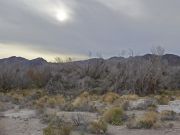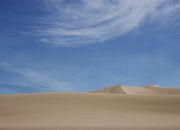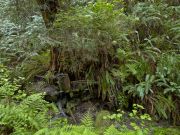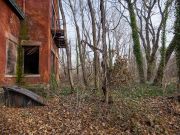Deborah O'Grady
Artist Statement / Bio
Deborah O'Grady's photography, spanning more than three decades, centers around the landscapes of the western United States. Many bodies of work represent an exploration of the rural landscapes of northern California seen within the context of native mythology (Pomo and Lake Miwok traditional stories, collected in the early 20th century by anthropologists working at UC Berkeley) and the pioneer experiences of an early settler, Susanna Roberts Townsend.
Talking Lake, placed photographs within a rich sound installation by composer Mark Grey, created from soundscapes, interviews and readings of texts.
crossings/fragments, continues this linking of image and text, weaving Susanna Townsend's scanned letters (written in a grid of criss-crossing script as a paper saving technique referred to as 'crossing') and scans of the ethnographic transcriptions of the Pomo myths collected by S.A. Barrett into the landscapes.
dreaming coyote, dreaming the world, commissioned by the Los Angeles Philharmonic for their festival of California music and projected throughout the concert hall lobbies, tells the story of the creation of Clear Lake through images of dawn and the story of Coyote traveling to the east and stealing the sun.
Deborah's territory expands to include the Navajo Nation and the Four Corners area of Utah, Colorado, Arizona and New Mexico for the creation of the video montage commissioned by the Phoenix Symphony for 'Enemy Slayer: A Navajo Oratorio,' and ' Code Talker Stories,' a book of oral histories and portraits of the World War II Navajo Marines whose native language was used to create an unbreakable code that aided in the defeat of the Japanese at the close of the war.
Her interest in the psychological aspects of landscape has made Deborah a regular featured presenter at the national Art & Psyche conferences, where she has created video montages to illustrate her spoken presentations. One of these, 'Following Seeker: Landscape, Music, Myth and Transformation,' is available online:http://aras.org/sites/default/files/docs/00036OGrady.pdf.
Deborah's most recent work, commissioned by the St. Louis Symphony, is a live-cued video set to composer Olivier Messiaen's 'Des Canyons aux Étoiles' (From the Canyons to the Stars), exploring desert landscapes of Utah and Southern California, from the pristine to the desecrated.
Deborah is co-creator of the patented Libra Acoustic Image System with architect Marci Li Wong and John Meyer, Helen Meyer and Pierre Germain of Meyer Sound Labs. LAIS a marriage of art and science designed to beautify the aural and visual environment of public spaces. In this format, her work may be seen in many restaurants and public spaces such as Berkeley's Brower Center, the Berkeley Repertory Theater café, Oliveto restaurant, Comal restaurant and the Meyer Sound headquarters in Berkeley, California.
Deborah's work has been seen in museums, galleries and concert halls worldwide, including Cologne and Mannheim, Germany; Stockholm, Sweden; Buenos Aires, Venezuela; Maryland Arts Place, Baltimore, MD; Art Museum of the Americas, Washington, D.C.; Bolinas Museum, Bolinas, CA; Gray Loft Gallery, Oakland, CA; Berkeley Arts Festival, Berkeley, CA; San Francisco Camerawork Gallery; University of California at Davis; University of Alaska at Sitka. She has been commissioned by the Los Angeles Philharmonic (dreaming coyote, dreaming the world for the Festival of California Music), the Phoenix Symphony (Enemy Slayer, A Navajo Oratorio), the Berkeley Symphony (Bitter Harvest). Other collections include The Public Policy Institute of California, Meyer Sound Labs, various medical and legal facilities, the University of Texas Harry Ransom Center for the Humanities, and the Coyote Point Museum (now called CuriOdyssey); Stanford University Rare Books Collection; and many private collections.
Key words: landscape, desert, National Parks, wildlife refuge, history, Native American, Navajo, ruins, Death Valley, Valley of the Gods, Code Talkers, graffiti, solar power, Zion, Bryce Canyon, Cedar Breaks, music, Central Valley, Lake County (CA)
Artist Essentials
- Contact Artist
- Artist Website
- Phone: 510-604-3660
Berkeley, California
United States
Northern America
Seed Artist
Artist Social
- Facebook: Deborah L OGrady
- X: @DeborahOGrady
- Instagram: debogrady49






